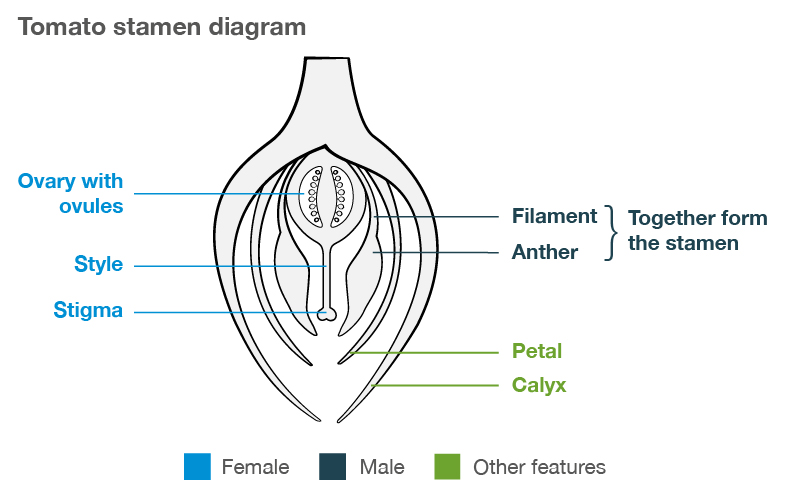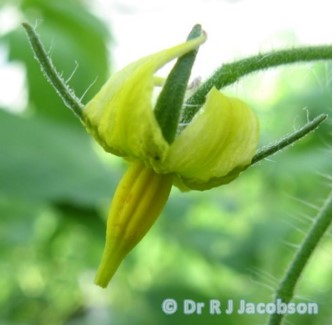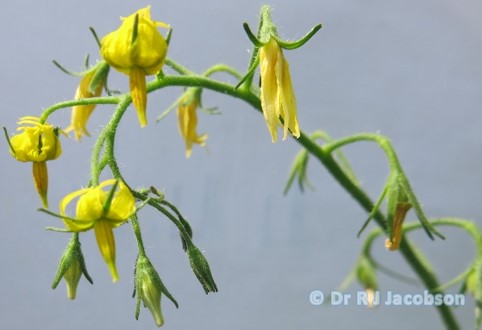Please click here to access the main AHDB website and other sectors.
- Home
- Knowledge library
- Tomato flower structure and fertilisation
Tomato flower structure and fertilisation
Read about the structure of a tomato flower and how it is fertilised
Tomato flower structure
- Each flower has five or more anthers united by interlocking hairs to form a hollow cone around the style. The neck of the cone consists of sterile extensions of the anthers, and these closely surround the stigma
- The anthers are bilobed and contain several hundred pollen grains which are released through longitudinal slits
- The flowers are pendant, and so, when released, pollen falls onto the stigma where it should germinate. The structure should allow self-pollination though the chances of success are enhanced by any form of mechanical disturbance.

Figure 1. Diagrammatic representation of a pendant tomato flower. Copyright of Rob Jacobson.
(NB: Female parts are shown in light blue text and male parts in dark blue text).
Pollen development and fertilisation
Very little research has been published on pollen development and fertilisation in tomato since the introduction of commercial bumblebees for pollination. Consequently, most of the available literature is pre-1985.
Pollen transfer
Mature pollen is ready for transfer at the time of anthesis (flower opening), but the stigma becomes receptive about two days previously and remains so for at least four days (Smith, 1935). Several hundred pollen grains may be released when the anthers open at anthesis and for 1–2 days afterwards.
The potential number of pollen grains is genetically determined, e.g. some Tomato Mosaic Virus (TMV)-resistant cultivars have less pollen (Laterrot, 1971), resulting in smaller fruits than previously grown cultivars (Alexander & Oakes, 1970). However, fruit set in the TMV-resistant lines was not inferior when their flowers were vibrated artificially as was common practice in commercial crops at that time (Picken, 1984).
Successful transfer of pollen grains to the stigma is dependent on the length of the style, and for self-pollination, the stigma must lie within the tip of the anther cone. The length of the style is both genetically determined (Rick & Dempsey, 1969) and affected by growing conditions (Rudich et al, 1977). As the optimum position of the stigma is just within the anther cone, extremes in either direction, which can be caused by poor light or high temperature, can result in poor fruit set. Pollen grains must adhere to the stigma to allow germination to take place. If the relative humidity (RH) is below 70% or the temperature is outside the range 17–24OC, the adherence of pollen may be reduced (van Ravestijn, 1970).
Fertilisation
Once pollen grains adhere to the stigma, pollen tubes start to grow within an hour and can reach the micropyle of the ovule within 12 hours at 25OC (Dempsey, 1970).
Fertilisation takes place once the nuclei from the pollen tubes penetrate the viable ovules. This has been observed after 18 hours, and most ovules would be fertilised within 30 hours at 20OC (Iwahori, 1966). It may not take place if the ovule has already deteriorated due to high temperature at the mother cell stage (i.e. about nine days before anthesis). Otherwise, fertilisation is not generally affected by growing conditions.
The extent of fertilisation (i.e. the number of fertilised ovules per ovary) is dependent on the number of viable pollen grains reaching the stigma and the effect of environmental or physiological factors on the subsequent processes of pollination and fertilisation (Picken, 1984).
Our studies with modern tomato cultivars
We have investigated flower development and pollen flow in tomato crops - focusing on baby plum (cv Funtelle) and cherry (cv Piccolo) (Refer to research projects PE 31a and PE 31b: an investigation into poor pollination performance by the native bumblebee, Bombus terrestris audax. In cv Funtelle, pollen was produced by two flowers per truss per day, in overlapping sequence, starting about three hours after sunrise and continuing until early evening. Bumblebee flight coincided with pollen availability.
These observations were broadly comparable to those made in cv Piccolo. However, in cv Piccolo there were many more flowers per truss, and up to four could be open at any one time.
There appeared to be considerably less pollen within cv Piccolo flowers than cv Funtelle. However, the anthers of each flower still had the potential to produce many more pollen grains than required to fertilise all the ovules in the ovary. Furthermore, it proved more difficult to manually extricate pollen from cv Piccolo flowers than from larger fruiting cultivars, but it is not yet known whether this affects the efficiency of bumblebees.

Fully flexed tomato flower with slight bumblebee visiting marks. © Dr R J Jacobson

Sequence of flowering on truss of cv Funtelle. © Dr R J Jacobson.
Useful links
Got a question? Ask a member of the team
Author
The content on this page was authored for AHDB by Dr Rob Jacobson (Rob Jacobson Consultancy Ltd) and Dr K Cockshull.

